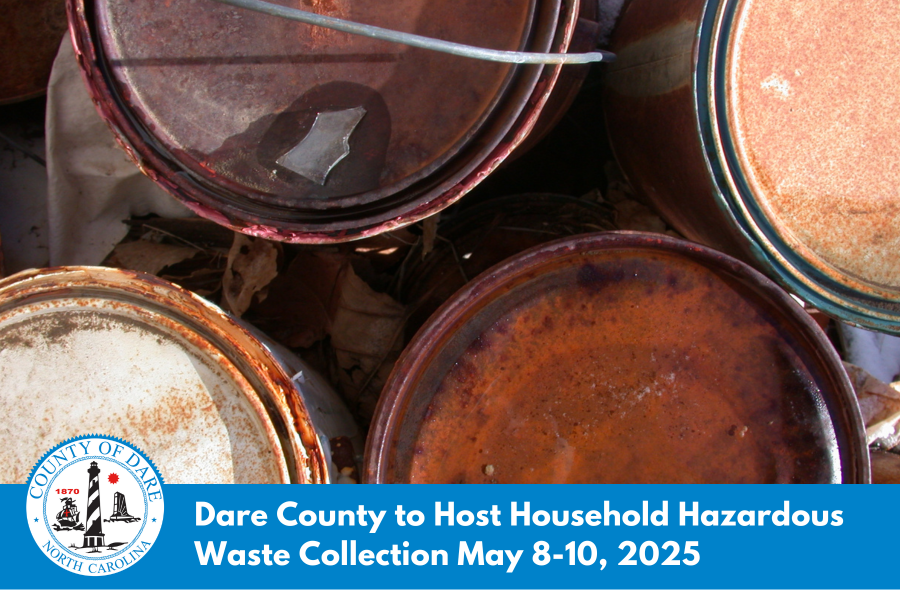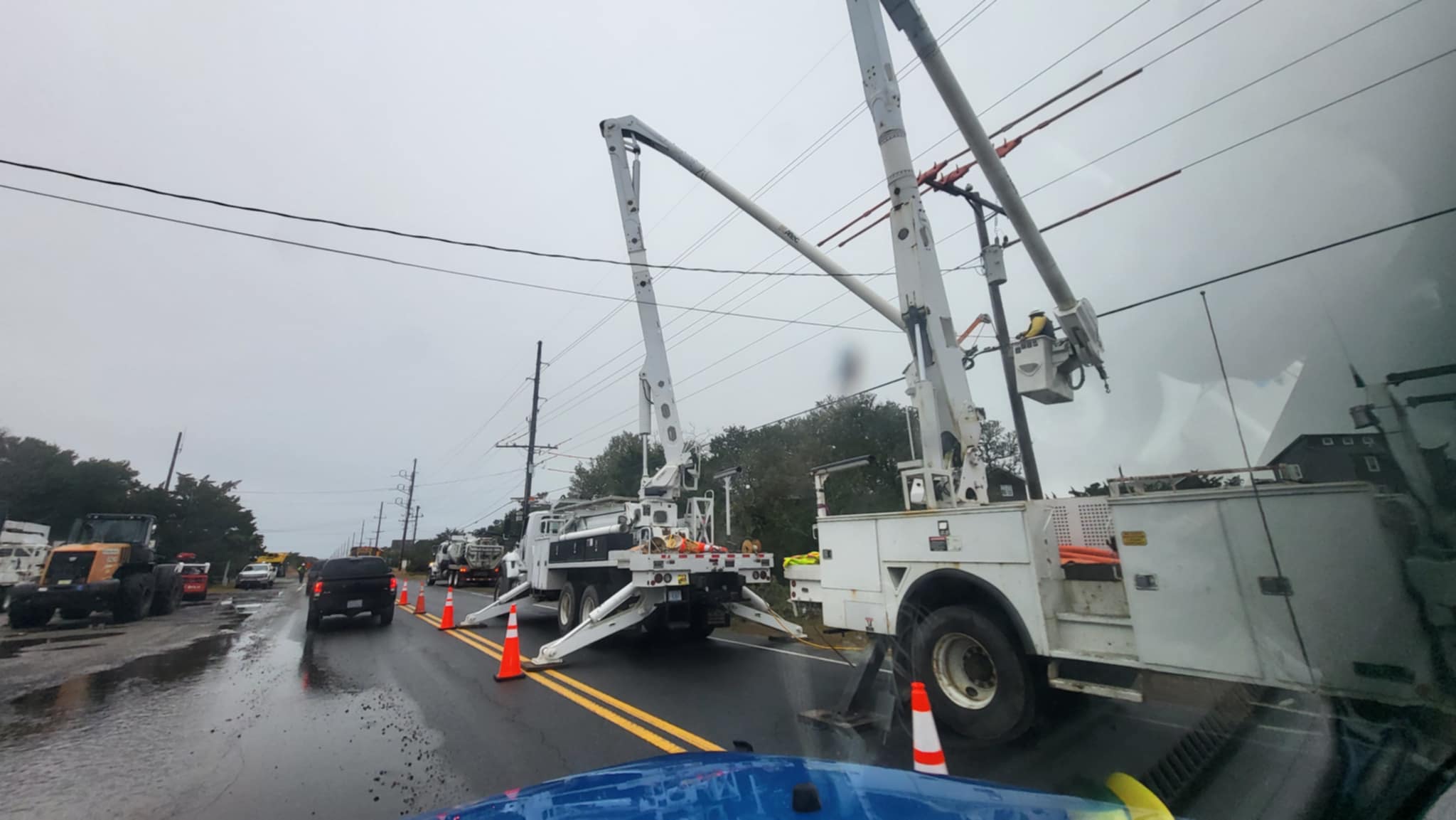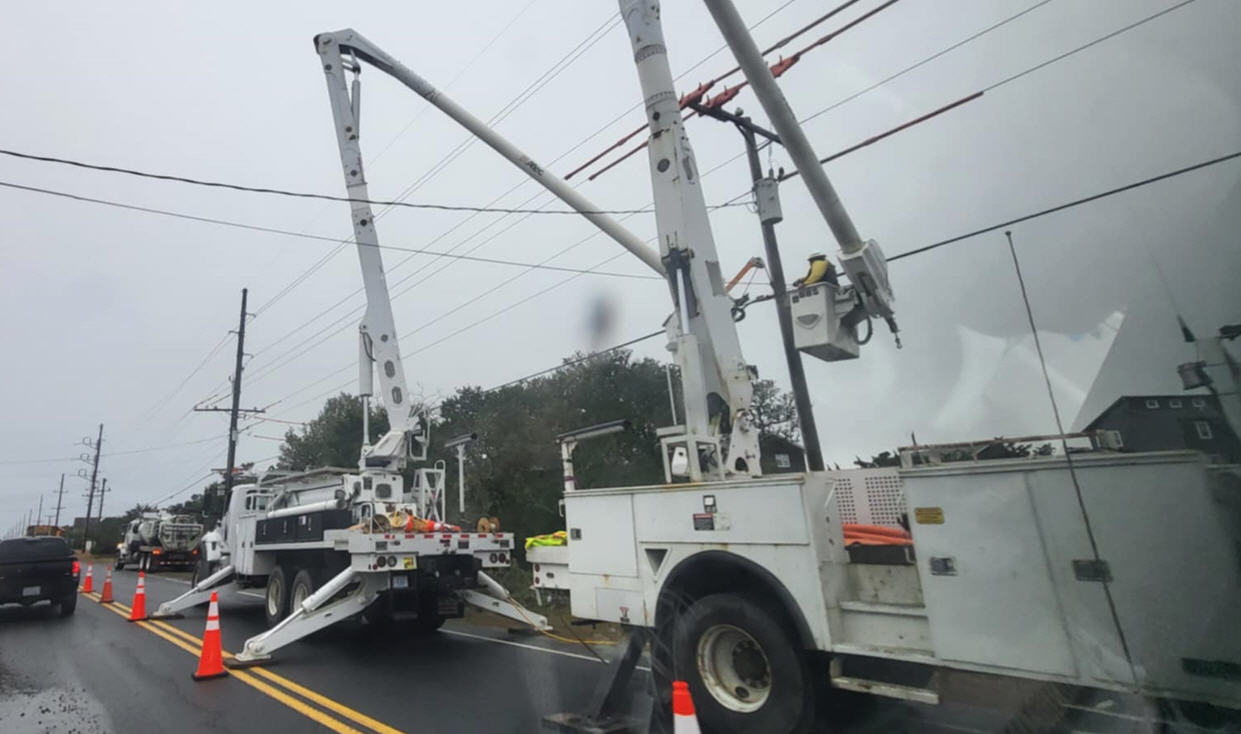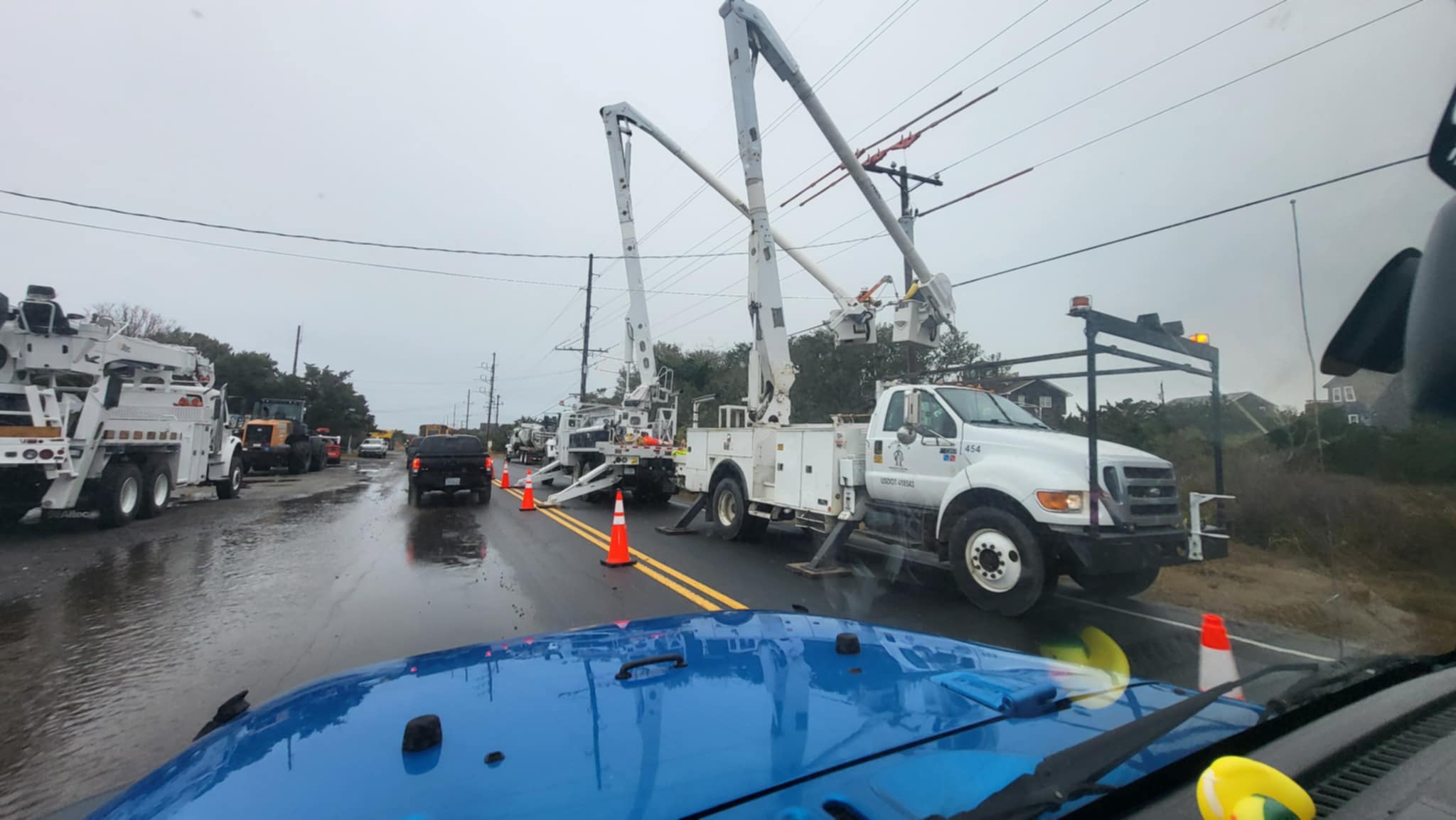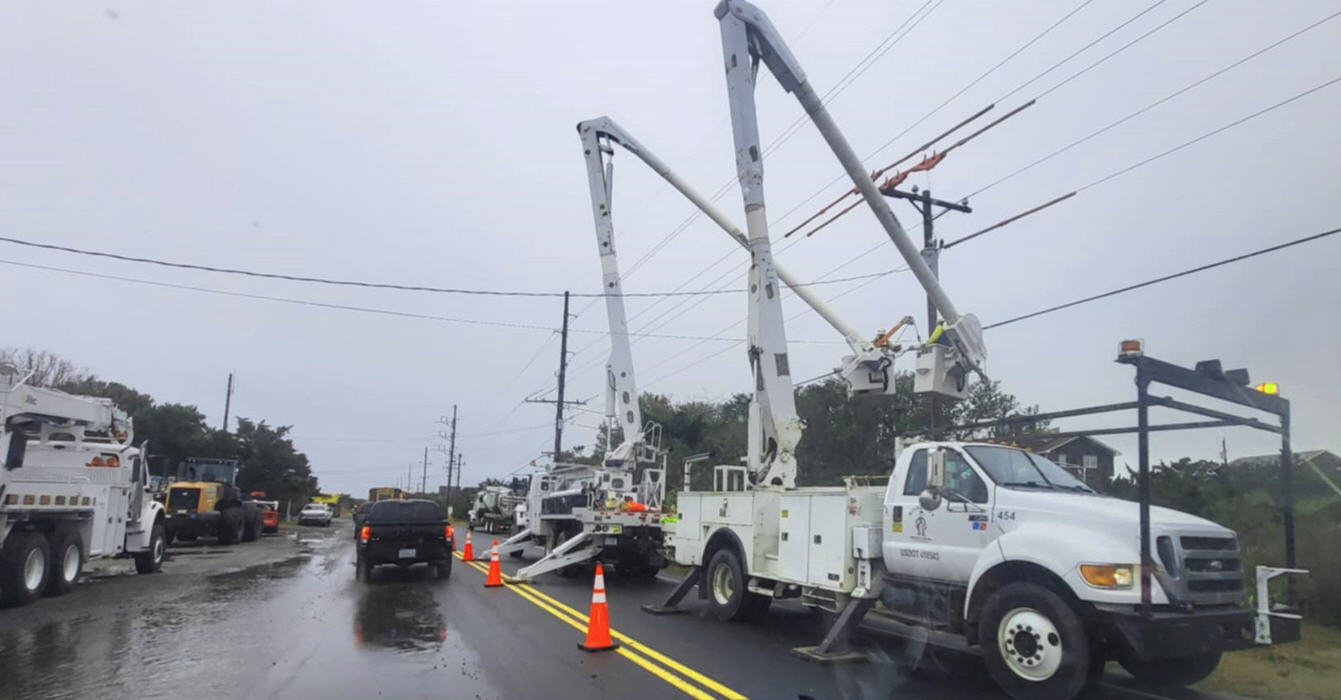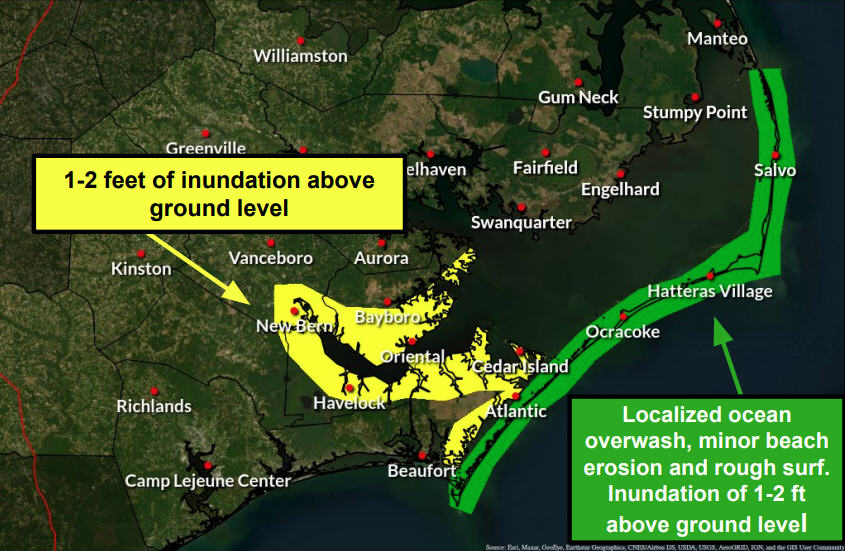FOR MORE INFORMATION The National Hurricane Center: http://www.nhc.noaa.gov/index.shtml? National Weather Service local forecast office in Newport, N.C.: http://www.erh.noaa.gov/er/mhx/ Weather Channel’s Hurricane Central: http://www.weather.com/weather/hurricanecentral
By IRENE NOLAN
By IRENE NOLAN
Most residents on Hatteras and Ocracoke were watching Tropical Storm Irene’s progress and forecast through the weekend, but today our attention was riveted to now Hurricane Irene, the ninth named storm and the first hurricane of the 2011 tropical season.
What looked early on to be a Florida – or even Gulf of Mexico – event now seems more likely to head north and east and threaten the Carolinas by the end of the week.
The storm became a hurricane early this morning, and as the day has progressed, weather models that forecasters use have been “trending to the right,” meaning that the forecast track of the hurricane was moving to the east and ever closer to Cape Hatteras.
Two of the global models take Irene over the Outer Banks, one near Wilmington, and one right in the middle from Camp LeJeune to Morehead City/Beaufort region. Then they take the storm either offshore running up the coast or on an inland track through North Carolina, Virginia, and the Chesapeake Bay.
As one Hatteras islander put it, we are now in “the cone of panic,” a humorous reference to the National Hurricane Center’s cone of probability for hurricane effects.
At 5 p.m. today, Irene was still at 80 mph and was located northeast of the Dominican Republic, moving west-northwest at 13 mph.
Forecasters stay the storm is likely to stay offshore of the Dominican Republic and Haiti and over warm, open waters as it heads to the Bahamas.
The upper level environment, said one Weather Channel forecaster, will allow it to “get nothing but stronger.”
Irene is not likely to encounter much wind shear and it will continue moving over very warm ocean waters.
It is expected to strengthen to a Category 2 – 96 to 110 mph – or even a Category 3 – 110 to 130 — as it heads toward its destination, probably some where on the southeast coast of the U.S.
Forecasters at the National Hurricane Center have not ruled out a direct or indirect influence on Florida, nor is it impossible that the storm could pass offshore of the Outer Banks.
Hurricane Irene was the topic of conversation today at most places that locals congregate from the post office to the grocery store.
And the storm will continue to be topic number one through the week. It will probably be Wednesday or Thursday before we have a really good idea of its path and intensity – and even then tropical systems are known for nasty last-minute surprises or reprieves.
Many of us are tuned to the Weather Channel, somewhat for the up-to-the minute forecasts but more so for Jim Cantore’s hurricane destination.
He was on Hatteras for Hurricane Earl’s brush by the coast just about a year ago. Will he be back again?
(Editor’s Note: I really appreciate the many funny and good-natured e-mails that I received today about the name of this storm. It is a curious situation. However, it won’t be necessary to keep on sending them all week! I really don’t think I have any influence over the storm that is my namesake, but I will certainly try my best to send it away from here.)
Most residents on Hatteras and Ocracoke were watching Tropical Storm Irene’s progress and forecast through the weekend, but today our attention was riveted to now Hurricane Irene, the ninth named storm and the first hurricane of the 2011 tropical season.
What looked early on to be a Florida – or even Gulf of Mexico – event now seems more likely to head north and east and threaten the Carolinas by the end of the week.
The storm became a hurricane early this morning, and as the day has progressed, weather models that forecasters use have been “trending to the right,” meaning that the forecast track of the hurricane was moving to the east and ever closer to Cape Hatteras.
Two of the global models take Irene over the Outer Banks, one near Wilmington, and one right in the middle from Camp LeJeune to Morehead City/Beaufort region. Then they take the storm either offshore running up the coast or on an inland track through North Carolina, Virginia, and the Chesapeake Bay.
As one Hatteras islander put it, we are now in “the cone of panic,” a humorous reference to the National Hurricane Center’s cone of probability for hurricane effects.
At 5 p.m. today, Irene was still at 80 mph and was located northeast of the Dominican Republic, moving west-northwest at 13 mph.
Forecasters stay the storm is likely to stay offshore of the Dominican Republic and Haiti and over warm, open waters as it heads to the Bahamas.
The upper level environment, said one Weather Channel forecaster, will allow it to “get nothing but stronger.”
Irene is not likely to encounter much wind shear and it will continue moving over very warm ocean waters.
It is expected to strengthen to a Category 2 – 96 to 110 mph – or even a Category 3 – 110 to 130 — as it heads toward its destination, probably some where on the southeast coast of the U.S.
Forecasters at the National Hurricane Center have not ruled out a direct or indirect influence on Florida, nor is it impossible that the storm could pass offshore of the Outer Banks.
Hurricane Irene was the topic of conversation today at most places that locals congregate from the post office to the grocery store.
And the storm will continue to be topic number one through the week. It will probably be Wednesday or Thursday before we have a really good idea of its path and intensity – and even then tropical systems are known for nasty last-minute surprises or reprieves.
Many of us are tuned to the Weather Channel, somewhat for the up-to-the minute forecasts but more so for Jim Cantore’s hurricane destination.
He was on Hatteras for Hurricane Earl’s brush by the coast just about a year ago. Will he be back again?
(Editor’s Note: I really appreciate the many funny and good-natured e-mails that I received today about the name of this storm. It is a curious situation. However, it won’t be necessary to keep on sending them all week! I really don’t think I have any influence over the storm that is my namesake, but I will certainly try my best to send it away from here.)
Most residents on Hatteras and Ocracoke were watching Tropical Storm Irene’s progress and forecast through the weekend, but today our attention was riveted to now Hurricane Irene, the ninth named storm and the first hurricane of the 2011 tropical season.
What looked early on to be a Florida – or even Gulf of Mexico – event now seems more likely to head north and east and threaten the Carolinas by the end of the week.
The storm became a hurricane early this morning, and as the day has progressed, weather models that forecasters use have been “trending to the right,” meaning that the forecast track of the hurricane was moving to the east and ever closer to Cape Hatteras.
Two of the global models take Irene over the Outer Banks, one near Wilmington, and one right in the middle from Camp LeJeune to Morehead City/Beaufort region. Then they take the storm either offshore running up the coast or on an inland track through North Carolina, Virginia, and the Chesapeake Bay.
As one Hatteras islander put it, we are now in “the cone of panic,” a humorous reference to the National Hurricane Center’s cone of probability for hurricane effects.
At 5 p.m. today, Irene was still at 80 mph and was located northeast of the Dominican Republic, moving west-northwest at 13 mph.
Forecasters stay the storm is likely to stay offshore of the Dominican Republic and Haiti and over warm, open waters as it heads to the Bahamas.
The upper level environment, said one Weather Channel forecaster, will allow it to “get nothing but stronger.”
Irene is not likely to encounter much wind shear and it will continue moving over very warm ocean waters.
It is expected to strengthen to a Category 2 – 96 to 110 mph – or even a Category 3 – 110 to 130 — as it heads toward its destination, probably some where on the southeast coast of the U.S.
Forecasters at the National Hurricane Center have not ruled out a direct or indirect influence on Florida, nor is it impossible that the storm could pass offshore of the Outer Banks.
Hurricane Irene was the topic of conversation today at most places that locals congregate from the post office to the grocery store.
And the storm will continue to be topic number one through the week. It will probably be Wednesday or Thursday before we have a really good idea of its path and intensity – and even then tropical systems are known for nasty last-minute surprises or reprieves.
Many of us are tuned to the Weather Channel, somewhat for the up-to-the minute forecasts but more so for Jim Cantore’s hurricane destination.
He was on Hatteras for Hurricane Earl’s brush by the coast just about a year ago. Will he be back again?
(Editor’s Note: I really appreciate the many funny and good-natured e-mails that I received today about the name of this storm. It is a curious situation. However, it won’t be necessary to keep on sending them all week! I really don’t think I have any influence over the storm that is my namesake, but I will certainly try my best to send it away from here.)
Most residents on Hatteras and Ocracoke were watching Tropical Storm Irene’s progress and forecast through the weekend, but today our attention was riveted to now Hurricane Irene, the ninth named storm and the first hurricane of the 2011 tropical season.
What looked early on to be a Florida – or even Gulf of Mexico – event now seems more likely to head north and east and threaten the Carolinas by the end of the week.
The storm became a hurricane early this morning, and as the day has progressed, weather models that forecasters use have been “trending to the right,” meaning that the forecast track of the hurricane was moving to the east and ever closer to Cape Hatteras.
Two of the global models take Irene over the Outer Banks, one near Wilmington, and one right in the middle from Camp LeJeune to Morehead City/Beaufort region. Then they take the storm either offshore running up the coast or on an inland track through North Carolina, Virginia, and the Chesapeake Bay.
As one Hatteras islander put it, we are now in “the cone of panic,” a humorous reference to the National Hurricane Center’s cone of probability for hurricane effects.
At 5 p.m. today, Irene was still at 80 mph and was located northeast of the Dominican Republic, moving west-northwest at 13 mph.
Forecasters stay the storm is likely to stay offshore of the Dominican Republic and Haiti and over warm, open waters as it heads to the Bahamas.
The upper level environment, said one Weather Channel forecaster, will allow it to “get nothing but stronger.”
Irene is not likely to encounter much wind shear and it will continue moving over very warm ocean waters.
It is expected to strengthen to a Category 2 – 96 to 110 mph – or even a Category 3 – 110 to 130 — as it heads toward its destination, probably some where on the southeast coast of the U.S.
Forecasters at the National Hurricane Center have not ruled out a direct or indirect influence on Florida, nor is it impossible that the storm could pass offshore of the Outer Banks.
Hurricane Irene was the topic of conversation today at most places that locals congregate from the post office to the grocery store.
And the storm will continue to be topic number one through the week. It will probably be Wednesday or Thursday before we have a really good idea of its path and intensity – and even then tropical systems are known for nasty last-minute surprises or reprieves.
Many of us are tuned to the Weather Channel, somewhat for the up-to-the minute forecasts but more so for Jim Cantore’s hurricane destination.
He was on Hatteras for Hurricane Earl’s brush by the coast just about a year ago. Will he be back again?
(Editor’s Note: I really appreciate the many funny and good-natured e-mails that I received today about the name of this storm. It is a curious situation. However, it won’t be necessary to keep on sending them all week! I really don’t think I have any influence over the storm that is my namesake, but I will certainly try my best to send it away from here.)
FOR MORE INFORMATION
The National Hurricane Center: http://www.nhc.noaa.gov/index.shtml?
National Weather Service local forecast office in Newport, N.C.: http://www.erh.noaa.gov/er/mhx/
Weather Channel’s Hurricane Central: http://www.weather.com/weather/hurricanecentral
FOR MORE INFORMATION
The National Hurricane Center: http://www.nhc.noaa.gov/index.shtml?
National Weather Service local forecast office in Newport, N.C.: http://www.erh.noaa.gov/er/mhx/
Weather Channel’s Hurricane Central: http://www.weather.com/weather/hurricanecentral
FOR MORE INFORMATION
The National Hurricane Center: http://www.nhc.noaa.gov/index.shtml?
National Weather Service local forecast office in Newport, N.C.: http://www.erh.noaa.gov/er/mhx/
Weather Channel’s Hurricane Central: http://www.weather.com/weather/hurricanecentral
FOR MORE INFORMATION
The National Hurricane Center: http://www.nhc.noaa.gov/index.shtml?
National Weather Service local forecast office in Newport, N.C.: http://www.erh.noaa.gov/er/mhx/
Weather Channel’s Hurricane Central: http://www.weather.com/weather/hurricanecentral
Subject
Name
(required, will not be published)
(required, will not be published)
City :
State :
Your Comments:
May be posted on the Letters to the Editor page at the discretion of the editor.
May be posted on the Letters to the Editor page at the discretion of the editor.
May be posted on the Letters to the Editor page at the discretion of the editor.
May be posted on the Letters to the Editor page at the discretion of the editor.







